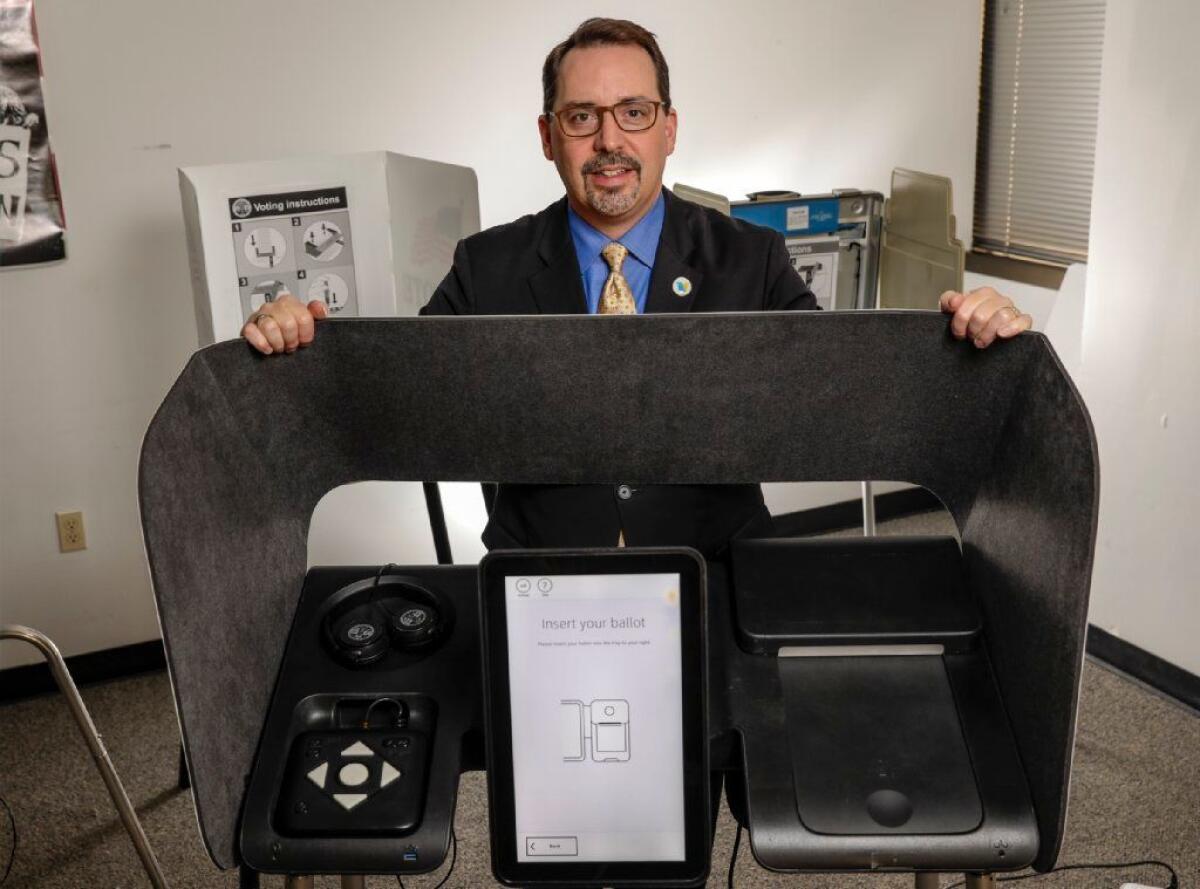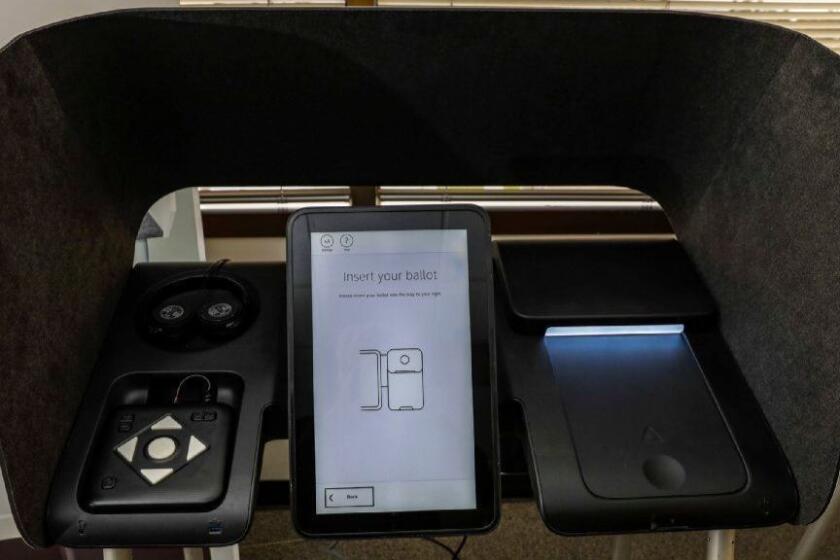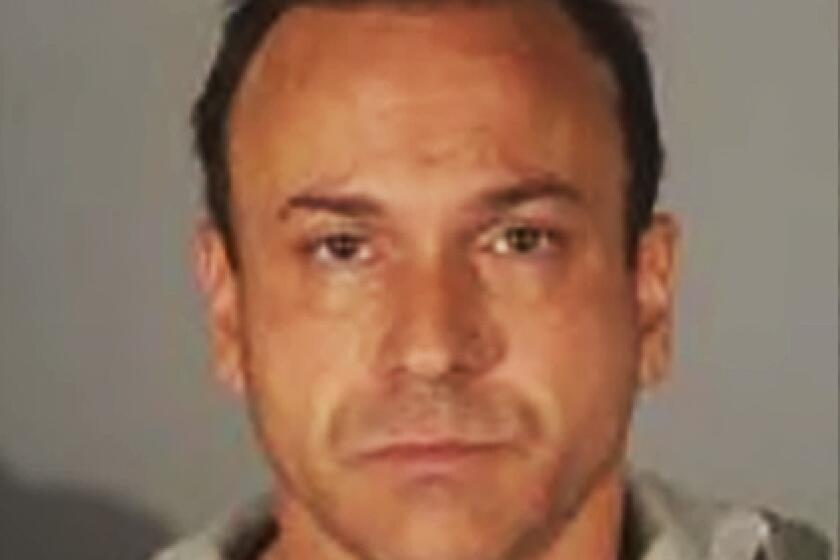Sweeping change is coming for L.A. County voters. If things go wrong, he’ll get the blame

Long before Dean Logan was the elections chief for the most populous county in California, he was an administrator for the most populous county in Washington state — and he was dealing with a crisis.
It was the fall of 2004, four years after the contested Bush-versus-Gore presidential election, and voters had just produced one of the closest gubernatorial contests in American history. Fewer than 300 votes separated the candidates.
Then things got worse.
Logan realized that his staff had misfiled a batch of uncounted mail-in ballots — enough to sway the election. Under pressure, Logan insisted that the ballots be counted, making him a target of critics, including the state’s Republican Party chairman who insisted that the election was being “stolen.” A judge eventually validated Logan’s decision.
Fifteen years later, the experience still haunts him. But it has informed and inspired his years-long personal quest to overhaul the way elections are conducted in Los Angeles County.
Starting next year, some 5.2 million residents — a figure that eclipses the number of registered voters in most states — will change the way they cast ballots. If the process goes awry — either in the earlier-than-normal presidential primary in March or in the crucial November general election, in which President Trump will probably be on the ballot — blame could fall on Logan yet again.
He says he’s ready, though.
Logan’s $300-million project, known as Voting Solutions for All People, or VSAP, is a massive undertaking that has been a decade in the making. It will replace L.A. County’s antiquated system with new machines and a new process in hopes of making voting easier, more secure and transparent.
Ballots — and the 31,000 new machines used to mark them — will look and feel different. The entire process will be more digital, but with analog components throughout for security and accessibility. Tallying all the votes should be simpler and safer. Polling places will change, too.
“His vision has always been to create a new voting system,” said Marilu Guevara, executive director of the League of Women Voters of Los Angeles. “He would have people voting at Starbucks, if he could find a responsible and secure way to do it.”
Much of the current process for voting in L.A. County — ballots, polling locations, vote tallying and more — will change for the primary election in March. Here’s what you need to know to be ready.
Passion for elections
Logan, whose official title is L.A. County registrar-recorder and clerk, is a man driven by his work.
Bespectacled and of average build and height, the 52-year-old talks about voting policy with the confident cadence of an experienced technocrat. Although he does enjoy drinking an occasional whiskey cocktail and singing karaoke with peers at industry gatherings, those who know him struggle to describe hobbies and interests, or even personal details other than his passion for elections and public administration.
Among the framed mementos on the wall of his seventh-floor corner office in Norwalk is a 1960s-era ballot collection bag purchased at an auction in Kansas, and a collection of vintage election buttons.
“You’re facilitating a process that’s really the cornerstone of our participatory form of government,” he said. “That’s really satisfying.”
Logan’s journey to becoming arguably the nation’s most important local elections official started in grade school. At 10 years old, a family friend decided to run for auditor in Kitsap County, in the Puget Sound area of Washington.
The campaign seduced Logan. He loved the yard signs and the fliers, and ultimately the friend’s victory. The experience led him to join political campaigns during junior and high school. He then skipped college to work at a county clerk’s office — first in licensing, then elections. It was an exciting time in the elections industry, Logan recalled, and the jobs with hands-on training were more appealing at the time than school.
Years later, in 1998, Logan decided to run for office himself, getting elected as a county clerk in Washington with 58% of the vote. He served one term.
He was then recruited to more prominent roles with Washington’s secretary of state’s office and King County.
Logan arrived in L.A. County in 2006 — two years after the disputed election in Washington state and after it was clear that the episode had irrevocably damaged his ability to inspire confidence in the voting process there.
“I’m better at my job here having been through that,” Logan said.
He began as a deputy to Conny B. McCormack, who retired before L.A. County could replace its antiquated voting system, first introduced when Richard Nixon won the presidency.
But when Logan became registrar-recorder and clerk in 2008, he set his sights on transforming the balloting process, starting with a principle that voters’ needs would come first.
He began by soliciting ideas from voting rights advocates, government officials and researchers, and eventually conducted public polling and focus groups. He didn’t want his assumptions about the electorate or the market for voting machines — or even the potential budget — to taint the process.
Along the way, Logan admits he wondered whether his team could pull it off.
“Will we have the support to make this real?” he asked. “Will there be the patience to see this through?”
Voter’s Choice Act
In March, the roughly 5,000 traditional polling places will be replaced by a smaller number of multipurpose “vote centers,” many of which will open 10 days before election day.
The centers will offer in-person voters more options. At at any of these roughly 1,000 locations scattered from Lancaster to Long Beach, voters can drop off absentee ballots, cast their vote on a newly designed ballot-marking device or update their registration. Eventually, all registered voters will receive their ballots by mail, and will be able to use them to vote by mail or in person.
Some of this new voting experience stems from the sweeping Voter’s Choice Act, which the California Legislature passed in 2016 and was a priority of Secretary of State Alex Padilla. It is optional for counties because it doesn’t come with state funding.
Although Logan isn’t directly responsible for some of the changes, they probably wouldn’t have happened without his blessing as the top elections official of California’s largest county.
More than 3.5 million people voted in the 2016 general election in L.A. County — with ballots printed in numerous languages — across 4,000 square miles. Therefore, experts say implementation of the law will be watched closely here, especially given that the electorate consists of so many underrepresented groups, including young voters, Latinos and Asian Americans.
Before the Voter’s Choice Act came together, Logan, Padilla and the law’s author, state Sen. Ben Allen (D-Santa Monica), were exploring similar ideas at the same time — and they all drew inspiration from Colorado. In 2013, that state mandated absentee balloting and eliminated traditional polling places in favor of voting centers across the state. There, any resident can immediately register to vote and cast a ballot early or on election day.
But while most of the California counties that have agreed to implement the Voter’s Choice Act have emphasized a switch to absentee ballots, Logan has taken L.A. County in another direction.
He is focusing on the in-person experience, ordering the creation of 31,000 specially designed ballot-marking devices and a new system to allow ready access to voter-specific ballots from anywhere in the county. He also is rolling out easier-to-understand mail-in ballots.
Those decisions were driven as much by history as by data: L.A. County residents are much less likely to vote by mail than residents in other counties across the state, helping make an investment for in-person voting necessary, officials say.
That made finding a vendor difficult. So Logan embarked on a process that resembled consumer product development in Silicon Valley, hiring a global design firm, IDEO, to design new voting machines. Each has a paper ballot scanner, large touchscreen, tactile keypad and headphones.
Logan says he cares about how the machines feel and the size of the type.
His office plans to continue developing the nonproprietary open source code, perhaps making it available to other agencies to use. The whole system is publicly owned.
‘An artist’s vision’
The stakes are high for implementing Logan’s vision, and his path to getting there hasn’t always been smooth.
Last summer, for example, he appeared before the L.A. County Board of Supervisors the week after a gubernatorial primary in which 118,000 voters’ names weren’t printed on rosters at their polling places, forcing thousands to cast provisional ballots. The error didn’t alter the results of the election, but it frustrated elected officials and led some candidates, including former L.A. Mayor Antonio Villaraigosa, to call for an investigation.
With the controversy swirling, Logan had to ask for an additional $300 million to buy equipment to complete his reforms of the election system. A delay would have derailed eight years of work and endangered his ability to make a hard deadline of March for the primary.
“It was uncomfortable,” he said of his appearance before the supervisors. “In some ways, it also really illustrated why we needed to do this.”
Logan got the board’s unanimous support, illustrating the trust that the supervisors have frequently shown in him.
“Dean’s the kind of guy that, if you’re in an airplane that has a problem in midair — he’s the kind of guy you would want as the pilot,” said Zev Yaroslavsky, who followed Logan’s progress before retiring as a supervisor and taking a research job at UCLA . “He’s extremely smart. He’s got an engineer’s mind with an artist’s vision. It’s really rare.”
But questions remain about the logistics of setting up the new machines, staffing the vote centers for the extended balloting period and ensuring the computer systems work without major glitches.
Voting rights advocates worry that such a series of massive changes will catch the public off guard. At a community meeting in May in the San Fernando Valley about the new vote centers, older voters expressed concern that their longtime precinct at a senior center would close, forcing them to travel to vote.
“Education is key,” said Guevara, of the League of Women Voters. “A lot of people will know about the nice technology that’s coming, and that will definitely be welcomed by voters. But my worst fear is that people will wake up on election day and go to their polling place and nothing is there.”
Logan said he is less afraid of a failure than he is of unmet expectations — say, for example, if only a small number of voters take advantage of the vote centers, leading to questions about the cost and necessity of staffing them ahead of election day.
His critics from his days in Washington state who have followed his career are skeptical.
“I will never forgive or forget what happened — none of us will,” said Chris Vance, who was chairman of the state Republican Party at the time.
The candidate who ultimately lost that disputed 2004 gubernatorial election, businessman Dino Rossi, feels the same way: “I just didn’t understand how someone with a record like that got hired,” he said of Logan.
Logan, who winces at the notion that his past might overshadow the work he is doing in L.A. County, casts his experience in Washington differently. He said it taught him the importance of transparency, of taking corrective action quickly to fix problems — and, ultimately, of safeguarding the public’s confidence in elections.
“I was leading an organization that didn’t live up to the expectations of the public,” Logan said of his time in Washington.
“That’s a lot to carry,” he said of his eventual exit. “There are different ways to approach that. You can either walk away from it and do something new, or you can power through it and try to make sure you avoid going through that situation in the future.”
More to Read
Sign up for Essential California
The most important California stories and recommendations in your inbox every morning.
You may occasionally receive promotional content from the Los Angeles Times.












